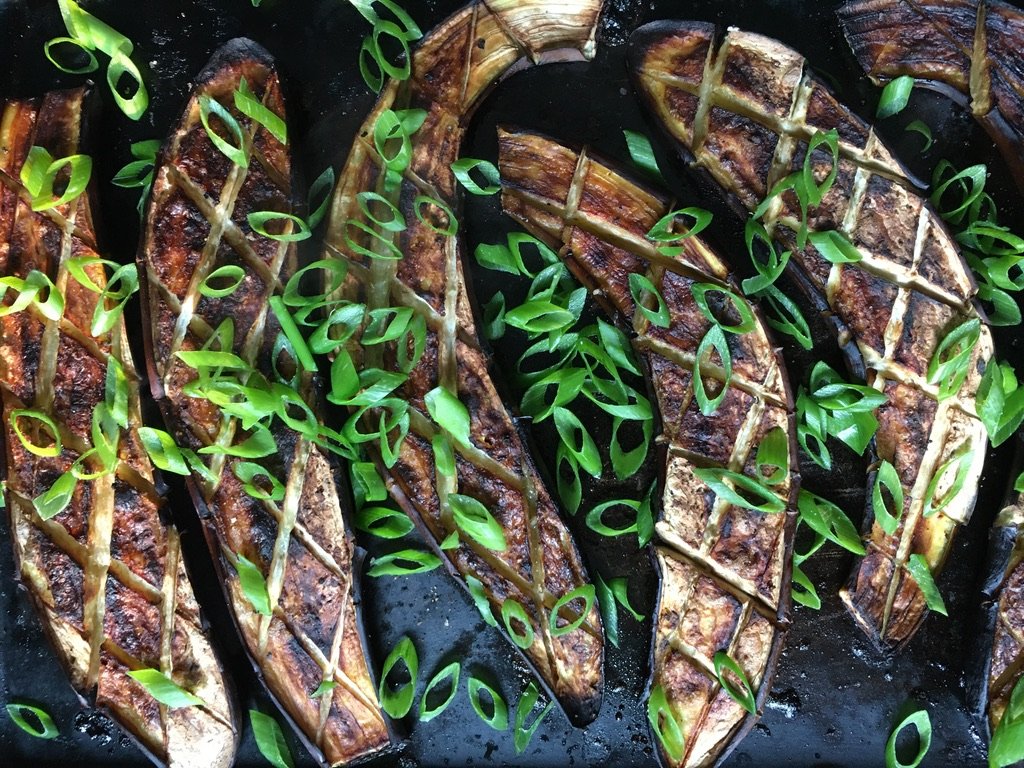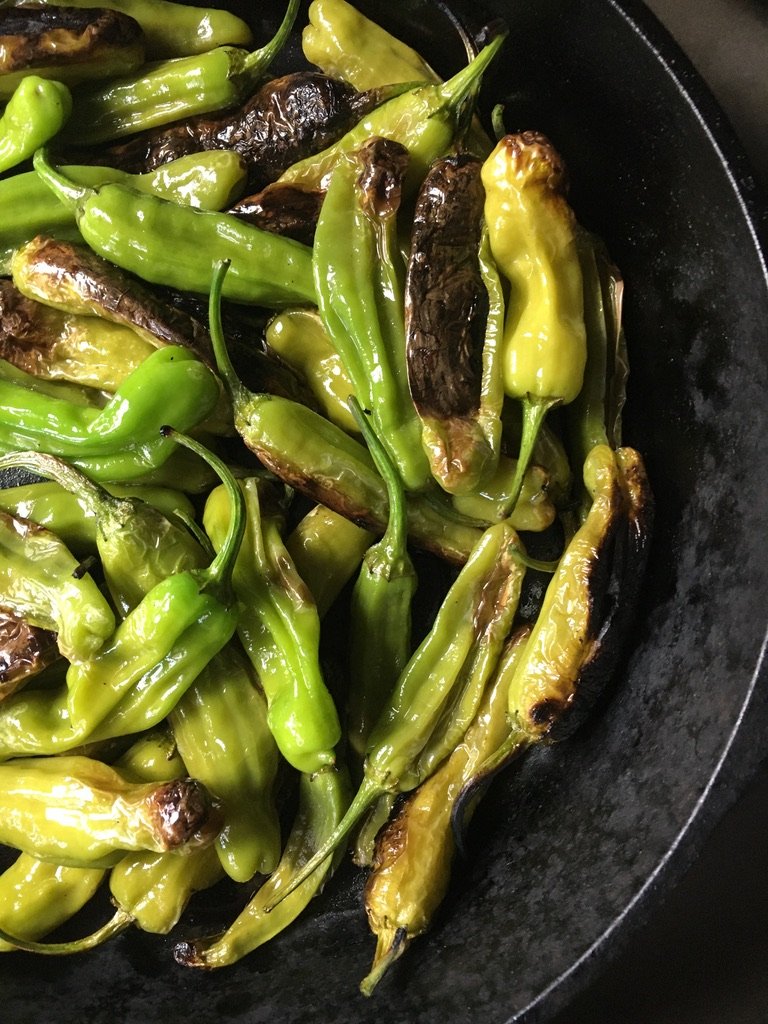July 10th, 2024
What’s in your share?
Eggplant* or Cherry Tomatoes
Shishito Peppers* or Beans
Cucumber
Zucchini
Salad Mix
Head Lettuce
Scallions
Japanese Salad Turnips*
*Shishito Peppers - are small, mild tasting peppers used in Japanese cuisine. Fun fact: about 1 in 20 is spicy! Consider yourself lucky if you get one (it’s nowhere near the heat of a jalapeno, so don’t worry too much). Shishitos have thin walls, which lend well to being blistered. We usually cook them as an appetizer to fend off our roommates while we’re cooking dinner. We never bother to cut them because they’re small enough to eat whole (minus the stem) and are best showcased on their own.
*EGGPLANT
*Japanese Eggplant - These eggplants are super underrated! Finding a good eggplant recipe is hard, but we’ve had amazing luck with the Japanese varieties. They have very small seed cavities, and less moisture content than Italian varieties, wildly reducing cooking time, and making for a less mushy/seedy dish. We love broiling and grilling them, adding them to kebabs and ratatouille, and baba ganoush is the absolute best and easiest way to have a really flavorful snack or meal.
Eggplant is a crop that often gets pushed to the back of the fridge. That said, we wanted to focus this newsletter on the eggplant because we know it can be one of those vegetables that is unfamiliar and perhaps even unappealing. But if I’ve learned anything from working in kitchens, cooking at home, and perusing cookbooks - it’s that the preparation technique influences the outcome of the dish as much as the health of the soil. So if you’re already starting with a fresh, healthy fruit (which you are!) and use a few solid cooking tips, you should have yourself a tasty eggplant dish.
Skin: Should you peel it? Up to you! If you’re following a recipe, do as the recipe says. I tend to like the skin if the eggplant is in slices or cubes, but if I’m roasting it whole, I may scoop the eggplant out as I eat it, using the skin like a bowl (similar to a baked potato)
Texture: We’ve found that our favorite eggplant recipes are simple ones that showcase the meaty texture of the fruit. Eggplants are satisfying to chew - they give weight to a dish, can be surprisingly filling, and are often used in place of meat in vegetarian dishes. Eggplants are full of water, so one goal that I always shoot for is to be able to control where that water goes, or replace it with another, more flavorful liquid. Cooking methods like grilling and broiling are effective at drying out excess moisture. Like a sponge, if you squeeze out the water, the flesh more readily absorbs other liquid. Salting and marinating eggplant is a great way to draw out some water and subsequently create negative space that is ready to absorb. Salting eggplant is arguably outdated, but it’s not illogical. Why Is Salting Eggplant a Thing?
How to Cut Eggplant: Here are a few visual examples of ways to cut eggplant from our friend, Martha. How to Properly Cut an Eggplant
Bitterness: We have never considered eggplant to be bitter. In fact, the eggplant varieties we grow are hybrid varieties; which have been selected to be sweet and productive.
Japanese or Italian: We love both, but they have their differences. The Japanese variety is smaller, reducing cooking time. Because of its shape, there is less concentration of water in the bulk of the fruit, making it ideal for sautéing and skewering. The Italian variety is probably more familiar. The fruit is meatier, making it ideal for layering and grilling in rounds. The water content is higher, so if you’re going to roast it in halves, we recommend scoring it (see photo) to create more surface area for water to evaporate while cooking. The skin on Italian varieties is thicker than the Japanese variety.
Baba Ganoush (my literal favorite dish of all time)
This dish pairs well with cucumber salad. Spread a dollop of baba ganoush on a plate and add a scoop of cucumber salad on top, with a toasted pita on the side. It can be used as a dip for cucumbers, radishes, or chips. I have never and will never peel my eggplant for this dish, but lots of folks do.
2-4 eggplants (cut in half the long way)
1/4 c tahini
1/4 c olive oil
2 cloves garlic
2-3 t salt
1/4 t cumin
parsley, oregano, mint, or scallions as garnish
Set oven to broil on high. Place eggplants on a sheet pan and salt. Broil the eggplants on the top rack for 30-35 minutes, turning once or twice during the cooking period. The eggplants should be blackened and scorched on the surface when done. After removing from the oven, rip or cut the stem off. The inside should be mushy. Place in food processor with tahini, garlic, and salt. Gradually add olive oil until you have a creamy texture. Salt to taste. Top with chopped herbs and black pepper for a garnish. Enjoy warm or cold.
Broiled Eggplant
Broiled Japanese eggplant. Scored, brushed with oil, and salted first. Broil for 20 minutes or until the inner flesh is soften enough to cut with a fork. Brush with miso paste, soy sauce, or gochujang. Pairs well with blistered shishitos!
2-3 eggplants (cut in half the long way, then carefully score the halves like in the photo. This will allow the eggplant to cook in the middle before it burns)
olive oil or sesame oil
salt to taste
scallions (finely chopped)
Arrange scored eggplants on a baking sheet. Drizzle with oil and salt. Broil for 15-20 minutes, checking often. They should be blackened on the top and soft in the middle. Eat as is, add to pasta or a salad, or add to an elaborate meal of other smoky and delicious things. Eggplant can also be grilled the same way.
*NEXT LEVEL: Prep in the same way, but add tomato sauce and mozzarella, and roast at 425 for 20-30 minutes.
Blistered Shishitos
Shishito Peppers (whole, with stem on)
2 T coconut oil, lard, or any other high heat oil
Sprinkle of salt (course sea salt is the best for this recipe, but any salt will do)
Splash of soy sauce OR lime juice- depending on the flavor profile you’re going for
In a frying pan, heat oil on high. You want the pan to be hot, so that it blisters the peppers without making them too soft. When the pan is hot, toss the peppers in. Saute for 3-5 minutes, using tongs to stir occasionally. When the peppers have a nice blister to them, turn the heat off and add the soy sauce or lime juice. Mix quickly and remove peppers from the pan. These are an awesome appetizer showcased on their own or atop a stir fry, creamy polenta, rice, or chili.
Meal inspiration: onigiri rice balls, grilled zucchini, broiled eggplant with miso, hard boiled eggs, blistered shishitos, cucumber, onion, and cherry tomato salad.




